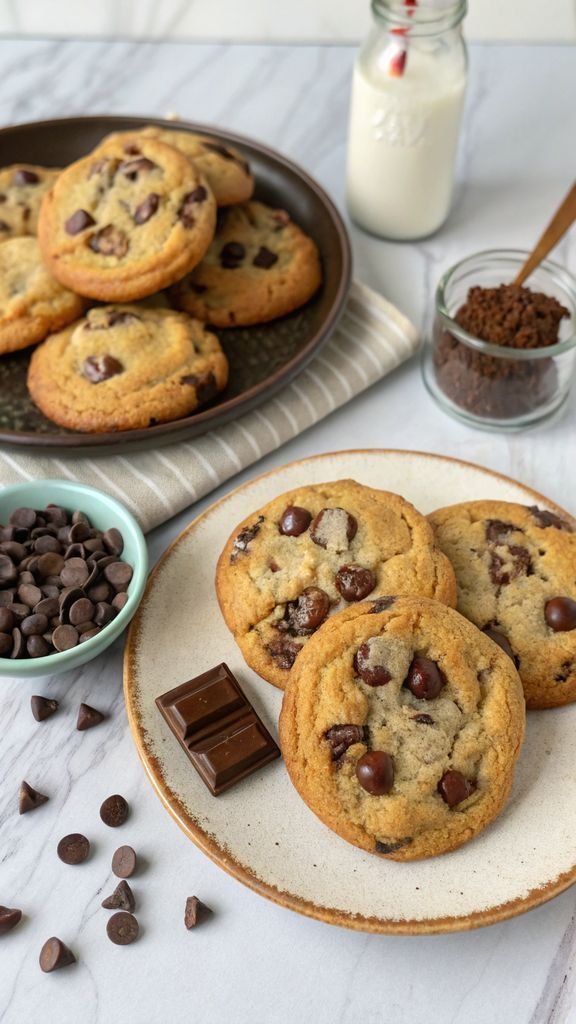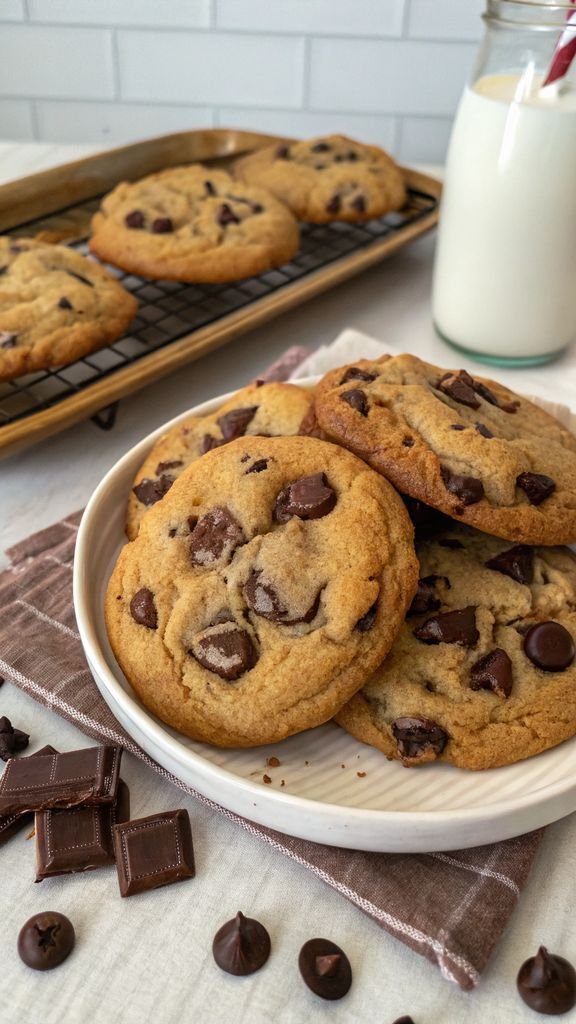
Few culinary creations evoke the universal sigh of contentment quite like a perfectly baked chocolate chip cookie. Born in 1930s Massachusetts at the Toll House Inn, this American icon emerged when resourceful owner Ruth Wakefield added chopped Nestlé chocolate to her butter cookie dough, expecting it to melt into the batter. Instead, those glorious chocolate “chips” held their shape, sparking a revolution. Today, these cookies aren’t just dessert; they’re edible nostalgia. They’re the after-school reward, the midnight solace, the “welcome to the neighborhood” gift. Their magic lies in the contrast: crisp edges yielding to a chewy center, pools of melted chocolate against a toffee-kissed dough. Whether dunked in milk or savored solo, they’re happiness baked into a palm-sized circle. I’ve spent years tweaking ratios and techniques to create my ideal version – balanced, reliable, and deeply satisfying. The image above captures exactly what we’re aiming for: golden-brown perfection with those signature chocolate pockets.
Why You’ll Love This Recipe
This recipe has earned its place as my most-requested treat for a reason:
– Perfect Texture Harmony: Achieves that coveted crisp perimeter, chewy middle, and slight bend without being cakey.
– Deep Flavor Complexity: A hint of extra vanilla and a pinch of flaky sea salt elevate the buttery, caramel notes beyond basic recipes.
– Consistent Results: Precise measurements and clear steps ensure bakery-quality cookies every time – even for beginners.
– Versatile Foundation: Master this dough, and endless variations (see below!) become possible.
Ingredients
Quality matters here – these humble ingredients transform under heat!
- 1 cup (227g) unsalted butter: Room temperature. European-style (higher fat) preferred for richer flavor.
- ¾ cup (150g) granulated sugar: Creates crisp edges.
- 1 ¼ cups (250g) packed dark brown sugar: Moisture and molasses depth for chewiness.
- 2 large eggs: Room temperature. Binds the dough and adds structure.
- 1 tbsp pure vanilla extract: Use the real stuff – imitation won’t deliver the same warmth.
- 3 cups (360g) all-purpose flour: Spooned and leveled. Unbleached flour yields better browning.
- 1 tsp baking soda: Freshness is key! Test by mixing with vinegar – it should bubble vigorously.
- 1 ½ tsp fine sea salt: Balances sweetness. Reduce to 1 tsp if using salted butter.
- 2 ½ cups (425g) semi-sweet chocolate chips: High-quality chips (like Ghirardelli or Guittard) or chopped bars. Milk chocolate can be substituted.
- Optional: 1 tsp espresso powder (enhances chocolate flavor without tasting like coffee)
Equipment Needed
- Stand mixer or hand mixer with paddle attachment
- Large and medium mixing bowls
- Whisk
- Rubber spatula
- Digital kitchen scale (highly recommended for precision)
- Measuring cups and spoons
- Baking sheets (light-colored aluminum)
- Parchment paper or silicone mats
-
30 cookie scoop (about 2 tbsp capacity)
- Wire cooling racks
Step-by-Step Instructions
1. Prep and Preheat
Bring butter and eggs to room temperature (about 1-2 hours). Butter should dent easily when pressed, but not be oily. Preheat oven to 375°F (190°C). Line baking sheets with parchment. Proper preheating ensures the dough sets quickly for ideal spread.
2. Cream Butter and Sugars
In your mixer bowl, beat butter, granulated sugar, and brown sugar on medium-high for 3-4 minutes until extremely pale and fluffy. Scrape the bowl halfway. This incorporates air – crucial for lift. As shown in the process photo, the mixture should resemble smooth, whipped frosting.
3. Add Eggs and Vanilla
Beat in eggs one at a time, fully incorporating each before adding the next. Mix in vanilla. The mixture might look slightly curdled – that’s okay!
4. Combine Dry Ingredients
In a separate bowl, whisk flour, baking soda, salt, and espresso powder (if using). Whisking prevents clumping and ensures even leavening distribution.
5. Incorporate Dry into Wet
With mixer on low, gradually add dry ingredients to wet ingredients. Mix just until no flour streaks remain – about 45 seconds. Overmixing develops gluten, leading to tough cookies.
6. Fold in Chocolate
Using a spatula, gently fold in chocolate chips. Reserve ¼ cup to press on dough balls later for visual appeal (see photo inspiration!).
7. Portion and Chill (Don’t Skip!)
Scoop dough into 2-tbsp balls (about 55g each). Place close together on a plate or tray. Chill uncovered for at least 30 minutes (or up to 72 hours). This solidifies the butter, preventing overspreading and deepening flavors.
8. Bake to Perfection
Arrange 6-8 dough balls per sheet, 3 inches apart. Bake for 10-13 minutes. Rotate sheets halfway. Cookies are done when edges are golden brown but centers look slightly underbaked and puffy (they’ll set as they cool). The image perfectly illustrates this ideal stage.
9. The Salt Kiss
Immediately after pulling cookies from the oven, lightly sprinkle with flaky sea salt. Gently press reserved chocolate chips onto the tops.
10. Cool Completely
Let cookies rest on the baking sheet for 5 minutes (they finish cooking here!). Transfer to wire racks to cool completely. Resist eating them hot – the texture improves as they set!
Tips for Perfect Results
- Butter Temp is King: Too cold = dense cookies. Too warm = flat cookies. Room temp (65-67°F) is non-negotiable.
- Chill Your Dough: This hydrates the flour and solidifies butter for chewy middles and defined edges.
- Don’t Over-Scoop Flour: Spoon flour into the measuring cup and level off. Packing it adds excess flour = dry cookies.
- Space Them Out: Cookies spread! Giving them room ensures even baking and airflow.
- Bake One Sheet at a Time: If baking multiple batches, keep dough chilled between bakes. Rotate sheets front-to-back halfway through.
- Trust the Visual Cues: Golden edges + soft, puffy centers = perfect doneness. They’ll firm up.
Storage and Make-Ahead Instructions
- Freshly Baked Cookies: Store cooled cookies in an airtight container at room temperature with a slice of bread (prevents staleness) for up to 5 days.
- Dough Balls: Freeze scooped dough balls on a parchment-lined sheet. Once solid, transfer to a freezer bag. Bake straight from frozen, adding 1-2 extra minutes. Dough keeps 3 months.
- Make-Ahead Dough: Refrigerate portioned dough balls in an airtight container for up to 72 hours. Flavor improves! Bake as directed.
Variations and Substitutions
- Nutty Delight: Fold in 1 cup toasted pecans or walnuts with the chocolate chips.
- Salted Caramel Swirl: Before baking, press a small piece of soft caramel into each dough ball.
- Gluten-Free: Substitute all-purpose flour 1:1 with a quality GF blend (like Bob’s Red Mill) and add 1 tsp xanthan gum.
- Dairy-Free: Use plant-based butter sticks (not spread) and dairy-free chocolate chips.
- Double Chocolate: Replace ¼ cup flour with unsweetened cocoa powder.
Note: Avoid using bacon or alcohol-based extracts; turkey bacon bits can be added for a sweet-salty twist if desired, though not classic.*
Maddy’s Tips for Success
From my countless batches to your kitchen:
– Brown Your Butter: For nutty depth, brown ½ cup (113g) of the butter first. Cool to room temp before creaming.
– The 24-Hour Chill: For unreal flavor, chill dough balls 24-48 hours. The wait is worth it!
– Mix-In Ratio: Stick to 2.5 cups max add-ins. Too much weighs down the dough.
– Cookie Size Matters: Use a scoop! Uniform size = even baking.
Frequently Asked Questions
Q: Why did my cookies spread too much?
A: Likely culprits: Butter too warm, dough not chilled, expired baking soda, hot baking sheet, or over-creaming. Ensure butter is cool, dough is chilled, and baking soda is fresh. Bake one test cookie first!
Q: Can I use melted butter?
A: Not recommended for this recipe. Melted butter yields thinner, crispier cookies. We want chewy centers!
Q: Why are my cookies cakey?
A: Too much flour or overmixing develops gluten. Measure flour carefully and mix only until combined.
Q: How do I make cookies thicker?
A: Ensure dough is thoroughly chilled. Try adding ¼ cup cornstarch to the dry ingredients for lift.
Q: Can I reduce the sugar?
A: Sugar affects texture. Reducing brown sugar yields crisper cookies; reducing granulated sugar makes them puffier. I don’t recommend reducing more than ¼ cup total.
Q: Can I use milk chocolate instead?
A: Absolutely! Milk chocolate chips or chunks work beautifully for a sweeter cookie.
Nutrition Information
Let’s be honest: this is a treat! A typical cookie (approx. 55g) contains about 220 calories, 12g fat, 28g carbs, and 2g protein. Dark chocolate offers antioxidants like flavonoids, while eggs provide protein. Enjoy mindfully as part of a balanced diet – sometimes joy is its own nourishment!
Serving Suggestions
- The Classic: Warm cookies with a cold glass of milk (dairy or oat milk for creaminess).
- Cookie Ice Cream Sandwich: Sandwich slightly softened vanilla bean ice cream between two cookies. Roll edges in mini chocolate chips.
- Dessert Charcuterie: Arrange cookies alongside fresh berries, a dollop of whipped cream, and a drizzle of caramel for a stunning platter.
Gather your ingredients, preheat that oven, and prepare for your kitchen to smell like pure happiness. Share your cookie triumphs with me using #MaddysCookieJoy! 🍪💛

